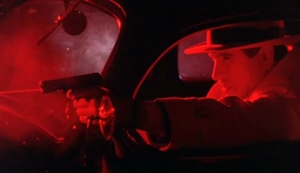
Most people have no idea how their movies are made, lacking even the faintest clue as how much of a Hell on Earth the process can become…especially once money’s involved. Throw in a well-known “property” (Hollywood-ese for an “idea”), a multibillion dollar movie studio, and a legend-in-his-own-time actor/director known for ball-busting levels of perfectionism and the irresistible compulsion to sexually harass anything that walks by him with breasts…and welcome to the Ninth Circle of Development Hell. Pull up a pot of boiling pitch and stay yourself awhile.
It took a little-known Tim Burton film called Batman to break the logjam between Disney, who put up the money (and own the film through their subsidiary, Touchstone Pictures), Tribune Media, who owned the idea, and legend-in-his-own-mind Warren Beatty, who secured the chance to direct himself in the lead role as every self-styled tough guy’s ultimate author-insertion fantasy persona, a man appropriately named Dick.
Plenty of people enjoy the Dick Tracy’s long-running comic book series. I’m not one of them, but there’s no denying its creator, Chester Gould’s contributions to the medium of comics. He transplanted the hard-boiled aesthetics of gangster films into a medium dominated (at the time) by housewives, washed-up prizefighters, and smart-ass kids. Seven years before Superman, Gould created a stalwart hero that stood for everything Right, True, and Just – a defender of the American Way. Eight years before Batman began his crusade against crime, Gould produced a pantheon of gimmicky, one-name villains to keep his hero busy. Many of them were grotesque to the point of caricature, their exteriors warped with little regard for anatomical concerns by their own interior ee-vil.
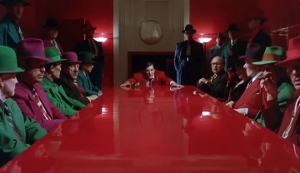
With this, as Batman’s creators would eventually learn, Gould set himself a trap, making his villains potentially much more interesting than his hero. In one sense, Dick Tracy-the-film is an attempt to walk back from that, centering itself (almost) exclusively around Dick and his supporting cast of Odious Comic Relief.
The film opens with one such – a street urchin known (for most of the film) only as The Kid (Charlie Korsmo). After ducking into one of the many, many, many anonymous garages dotting this City, The Kid witnesses a gangland murder. He runs afoul of legendary police detective Dick Tracy after he just so happens to steal a watch from someone at the diner Tracy just so happens to frequent on his way home from The Station.
After beating The Kid’s Dickensian father figure down, Tracy pawns The Kid off on Tess Trueheart (Glenne Headly), Tracy’s loyal Designated Love Interest and doorstop. After all, somewhere there is a crime happening…and given the thin veneer of 1930s Chicago overlaying this hyper-stylized universe, you can bet your ass there’s an ee-vil crime boss behind it all.
Alphonse “Big Boy” Caprice (Al Pacino) will be that crime boss for the remainder of the picture: a shouty, hunch-backed, one-note excuse for Pacino to overact. (As if he’s ever really needed that.) Big Boy’s on a mission to subsume The City’s criminal gangs into one organization – his. We first meet him as he orders the death of local night club impresario Lips Manlis (Paul Sorvino) and makes off with Manlis’ girl/star attraction, the wonderfully-named Breathless Mahoney (Madonna).
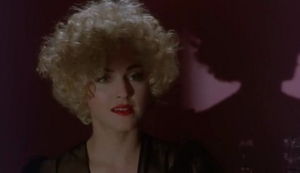
Big Boy’s on-going war of attrition against Tracy forms the film’s laughably-thin excuse for a plot. Later on there’s a bit featuring the character Steve Ditko unabashedly ripped-off when he created The Question, but that’s all secondary to the film’s real focus: a flaccid, predictable love triangle involving The Hero, the Good Girl and the Feme Fatal. What a dee-lightful surprise. Never seen one of those before.
Thanks to a lifetime spent watching Bond films, I’ve developed a healthy and natural fear of blonds in slinky black dresses. If you’re a legendary police detective sworn to uphold The Law such women bring nothing but sad tidings…especially when they neglect to don underpants before they leave the house. After Tracy arrests Big Boy for the murder of Lips Manlis, Breathless takes an instant shinning to Dick…because that’s just what people do in this universe. (Unless, of course, they’re Criminals, in which case they cower and hiss, the way vampires used to whenever you flash them with a cross.) He wants her to testify; she wants in on his pants. This sets up a bevy of scenes where Dick tries (and fails) to thread the needle between the two. He takes advantage of Tess’ Brobdingnagian patience. He absorbs Breathless’ endless supply of come-ons. He gets kidnapped. The Kid saves him. He arrests someone. They refuse to turn on Big Boy. Lather, rinse, repeat for an hour and forty-five.
Chester Gould originally conceived all this as a comic book rendering of the Chicago he saw when he first became a cartoonist for the Tribune in 1931. So Dick’s our Elliott Ness, Big Boy’s our Al Capone, and if Beaty were Brian De Palma this could all be The Untouchables. He’s not, preferring static shots to Steadycam tracks, creative editing, and a retro feel that intentionally hearkens back to the German Expressionist and American gangster movies created around the time Tracy achieved his first big wave of popularity.
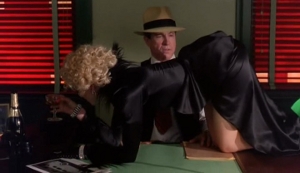
All of which is noble in spirit but leaden in pace and dull as hell in its execution.
It’s a problem of character. Al Capone’s idea of fun included laying out a banquet for his enemies before he tied them to their chairs beat them to death with a baseball bat. Al Pacino lacks the personal touch you need to really put the fear into a crime syndicate, especially when all your foot soldiers are mooks, mugs, and idiots. He mistakes volume for menace, which might’ve worked on-set, where the actor’s personal charisma and physical presence could subconsciously work on the minds of his audience. Thanks to the distancing effects of film, Pacino’s Big Boy ends up looking like a screaming putz – a mad man with a mouth so big I’m amazing he survived adolescence without catching a double-tap to the back of the head.
I suppose this is why everyone “misunderestimated” Hitler: Awww, honey, look at the cute little, shouty man. Isn’t his impotent rage just to die for? And that little mustache is just so cute. No, dear. It’s really not. Glenne Headly, now…there‘s cute for ya. (Redheads, man…raaow.) Especially since her hair is color coordinated with every other shade of red in Dick Tracy‘s world.
No bones about it: the film’s production design is unique to the point of having never been truly been equaled, not even by the most colorfully audacious superhero productions of the 2000s. There are only seven colors in the entire film, allowing the bright, garish foregrounds to (almost) seamlessly blend with the matte painting background…and there’s a joke in there somewhere about the city’s population as a whole being whiter than Ward Cleaver’s secret cocaine stash. The entire thing – right down to the sappy melodrama that goes exactly where you’d expect it to go and takes its own sweet goddamn montage-heavy time – feels like a protracted love note to a comic book that obviously changed someone‘s life.
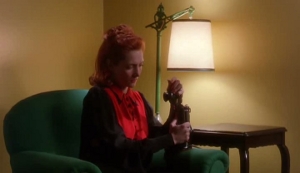
I guess it’s okay, if you like this sort of thing…or if you have some medical condition that can only be cured by staring at Warren Beatty’s face…but honestly, there’s a reason Tracy earned his reputation as a classic Cop who Doesn’t Play By the Rules. Like Dr. King’s arc of history, Tracy always bends toward justice. The Bad Guys in his world are Forever Evil, and the Good Guys (i.e., the three other cops who, with Tracy, seem to make up this City’s entire plainclothes police force) while good, would have their asses handed to them by street thugs were it not for Dick. He’s the one who sweats suspects. He’s the department’s brains, spinal column, and entire central nervous system. He’s the one who trespasses onto private property for the sake of planting illegal listening devices. He’s the one who tosses the Letter of the Law into a big communal bonfire while his armies of yellow trench coat-wearing followers march about it shouted “Zeig heil!”
He’s everything you’d expect from a man named Dick: honest, tough-minded, hard-fighting, quick-shooting. Professional to a fault, so wrapped up in his work cleaning the mean streets of Wherever This Is he can’t even stammer out his true feelings for Tess by the film’s end. And no, that is not a Spoiler, since the ending’s obviously meant to set up an Inevitable Sequel and stalwart heroes who can’t express themselves were already cliched by the time Achilles died. They’re easy to write and, if you already believe yourself a tough guy, even easier to play on screen. But no matter how much I enjoy the calm, Professional Badass demeanor Beatty supplies, there’s one millstone continually choking his performance: Dick Tracy is too good. Too upright. He walks right over the line between Stalwart Hero and One Dimensional Dick, and doesn’t even have the courtesy to offer it its one phone call.
There’s a reason why the Stalwart Hero fell on such sad times in the last half of the twentieth century: he’s boring. Dress a concrete block in a yellow trench coat and it’s garish color might be distracting, but eventually people are going to move on. Scratch the surface and you’ll just find more surface…and get a lot of yellow under your fingernails. The makers of actual noir realized this, which is why all the best protagonists come across as either assholes or tortured antiheroes.
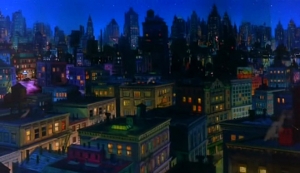
When he shortsightedly dismissed Batman Returns, Roger Ebert declared that “the very essence of noir is that there are no more heroes.” Dick Tracy attempts to marinate noir films in a garish, comic book color scheme. The result, ironically enough, is too morally black-and-white to qualify as noir, and once the awe and wonder of the production design wears off the story’s too route to excite. Actual noir detective movies avoid this by showing their heroes protagonists constant struggle against the illusionary moral absolutes this corrupted, dying culture of ours ceaselessly repeats. Dick is a moral absolute on legs, so his story is surprisingly drama-free…especially given the amount of shootouts, fist fights, and chances to bone Madonna that make up its moving parts. We know Dick’s not going to take those chances… just like we know there’s no chance he’ll let The Kid get shipped off to that orphanage. (Pint-sized sidekicks don’t grow on trees.) We know that, in the end, he’ll be driven back into the sheltering arms of the Good Bond Girl, the status quo safely restored in time for his Next Adventure.
Faced with this inescapable knowledge, there’s nothing to do but sit back and wait for the film to catch up to us. But if you like this sort of thing, have at it. You’ll get plenty of Madonna vamping, plenty of Warren Beatty’s face, and plenty of Al Pacino at full volume. Enjoy it while it lasts. At this point, Development Hell’s denied us that Inevitable Sequel for neigh on twenty years. Frankly, I couldn’t be happier.
At least Darkman still exists. That’s how we know, not only that superheros and film noir can go together, but that the year 1990 wasn’t a complete and total loss.
![]()
![]()

Tsk, tsk, tsk. What a vinegar pissing review of a wonderful tribute to a comic book hero. The movie is a great work of art that doesn’t try to be anything but a tribute and at that, it succeeds.
Hence the qualifier “if you like this sort of thing.” I only used it twice. Was that not enough?
Warren Beatty sock puppet account detected!
Nah, just one of my (apparently many) admirers from the Netherlands…and we all know how they are.
I’m just kidding. I love the Dutch! Every tulip-planting one of you. You sheltered my father and I during the black, evil Christmas of 2001, and I am forever in your debt. Specifically, Amsterdam’s. It was cold as Dante’s hell, smelled of fish and diesel fuel, but by God it was the best possible place to be, especially for two Americans on vacation.
Damnit. Now I sound like a colonialist.
I am a big Dick Tracy fan and have been for years. As a kid in the 70s I found reprints of all the old Dick Tracy comics from the 1930s and 40s and read them through. Today I’m buying the happily newly released complete series (I plan to stop the moment they get to Moon Maid, though)
Despite my love for Tracy, your review of this film is spot on. Beatty’s Tracy gets wrong everything that Gould did right. His villains had far more panache than in the film, and so did his heroes. Blech.
While not a fan of Tracy, a life-long love of other comics has provided me plenty of abject lessons in how Hollywood continually sodomizes our favorite stories. You, and all Tracyites, have my sympathies. (Except for the Queen of the Desert, up top there.)
A tedious exercise that rolled itself out after Burton’s equally tedious (but financially-if not artistically successful) Batman. Self-masturbatory,over-long,and focused too much on an ego-maniacal producer/star whose relevance had long since passed. It also proved Madonna was the hack everyone pretended she wasn’t. I wish I could wipe it from memory-the problem being there are 1,000 more lame comic book adaptations to take its place.Is there really a good one? I have yet to find it.
A good adaption? No. I stopped looking for that rare bird long, long before directors began “faithfully” filming Frank Miller’s comic books. Instead, I’ve come around to feel good distillations are the best we can reasonably hope for out of the micro-managed, corporate complexes that turn comics into movies. In which case, good distillations are almost a dime a dozen, though each remains flawed in their own special ways. The Iron Man series and Chris Nolan’s Batman movies are the best recent examples of this. One could consider them both (separately or together) as emblems of all the pitfalls and promises inherent in our current Age of Superhero Movies. A straight comparison between the two, complete with contrasting evaluations, would probably read like an itemized list of what To and what Not To Do when making superhero films…and who knows? I just got The Dark Knight for Christmas and might actually make such a list one of these damn days. ‘Til then, I refer everyone else to the Vaults. Anything over a two-G is at least bearable. Unlike, say, films based on the later day works of Frank Miller.
I never took Big Boy seriously and I doubt Pacino’s intent was to take him very seriously. I enjoyed the character and he was refreshing compared to the bland Dick Tracy. In general, the movie is a well done spectacle. Not the best kind but fun.
As for the talk of Batman, I am sorry but Nolan’s Batman films have been terrible. His Batman, and his Batman universe, is far too grounded in reality. Nolan’s Batman/Bruce Wayne is little more than an angry guy in a costume with a stupid voice. I got nothing from the character in Batman Begins. All we learn is how he learned how to fight and where he got his neat gadgets. That’s it. No real conflict between his public and private life. Burton’s first film illustrated the tragedy of Batman so much better because in a subtle way, everything focused on the night Wayne’s parents were killed. For example, the very first crime committed in the film was parents mugged right in front of their child and several scenes with the Monarch Theatre in the background. Add screwing Vicky Vale then dumping her to return to that lonely life of brooding over his parents and you got some great character development.
The Dark Knight was not much better than Begins. Yes the action was an improvement but the film was overstuffed with pretension. Time after time the characters get on a soap box to state the obvious themes. Seriously, how many times did we see a close up of a characters face making a pretentious speech with the Hans Zimmer score blaring ? That is like every other scene.
What I find so odd is that Nolan will go into the depths of fantasy for Inception but when it comes to Batman, he seems almost embarrassed by the material he works with. When Nolan makes his last Batman film, and I believe Rises may very well be his last, I will be glad. Maybe someone with a more creative vision, and a basic understanding of story structure, will come and elevate Batman to new heights of creativity.
Tim Burton did a better job in his first film because he made the character a myth in the vein of a classic horror figure. Nobody knew if he was just a crazed killer, a vigilante, or both. Such mythos were never raised in Nolan’s films. I say all this as a huge fan of Bats, especially the stories written by Stephen Engelheart
BTW, best superhero film, IMO, is Superman ’78.
That’s part of why I’ve avoided Donner’s epic until now, save when Bryan Singer left me no other choice. I respect your critique of Nolan’s Bat-films without completely agreeing. I can’t call them “terrible” since Batman and Robin and 1966’s Batman: The Movie still exist and mine eyes have not seen such terror either before or since. And despite the many unnecessary monologues cluttering up The Dark Knight‘s multiple climaxes, I can’t call them “pretentious.” The subtlety you see in Burton’s Bat-films is there, but it’s a distant, disinterested thing, flowing from the fact that Sam Hamm is a better screenwriter than David Goyer or the Brothers Nolan, who learned well their lessons from Following and Memento. Unfortunately, that lesson amounted to “Play it loud! Bang it out for the cheap seats and the ADD-addled douchebags snickering in the back row. Otherwise, you’ll never get anywhere in this business.”
Still, you seem to have got it a bit backwards. Burton was the one embarrassed by superhero comics until The Dark Knight Returns and The Killing Joke came along and convinced him there was, in fact, something to all this. He was the hot young Turk about town in who could make hits (or, at the very least, one hit: Pee-wee’s Big Adventure) on a shoestring budget, and Warner Brothers hired him in the hope that he would be a star-struck, New Meat kind of director who’d take orders and shut the fuck up. Things worked out differently of course, for which I am exceeding glad, but he it was who first decided to “ground” the Batman in a post-noir, urban hellscape full of steam and moodlights. Gotham City would not be the nightmare it is today without Burton’s Hammer Horror sense of aesthetics, and I would not be the fan I am if not for his film. And it’s because Burton’s Batman exists I’m even more gladder for what Nolan managed to do ten years after Burton jumped ship and make not one, but two Batman films that are actually about Batman, for once.
For all that, I’m not a Nolan partisan. If it’s a choice between Batman and Batman Begins, I’ll choose Mask of the Phantasm every time, hands down.
David:
I never felt Burton’s themes in Batman to be disdant because there is a ton of reminders of his pain littered in the film as I explained. I prefer that over shoving every little theme in one’s face which is a standard of bad, modern writing. Burton’s Batman is tragic and pathetic. He also was torn between two worlds Nolan’s Batman on the other hand is just angry and one dimensional. He was just a machine battling crime. I didn’t feel one bit emotion from him. Also it dosen’t help that Christian Bale is a weak actor with no charisma. As for Burton “grounding” Batman, I hardly agree. Sure, Batman’s emotions were taken very seriously but he was a myth in those films. Everyone talked about Batman like he was a monster and he appeared like a classic horror figure in the vein of Nosferatu. And look at Gotham City, we really must have different tastes. “Hellish” is the last word I would describe that wonderful set. I love the classy art deco look combined with german expressionism. That Gotham was certainly mean looking but certainly not souless unlike Nolan’s “Micheal Mann-esque” Gotham. I also agree that Burton certainly was anything but a comic book fan but at least he used his imagination. Isn’t that what comics are about ? Imagination. Nolan only on the other hand didn’t even want to be fantastic. He wanted something like Heat.
Lastly, you are so right about Mask of The Phantasm. I was really only comparing the live action works.
Correction, I will agree with “Hellish” but definetly not souless.
Then we’re both of a mind to make some mookie.
Ha Ha ! Yes exactly.
Getting back to Dick Tracy though, what would have made film better is Breathless was more than just a “seductive blonde”. What she should have been was a jezebel or at least representing a gray era that Dick Tracy that could never cross. That would have added a critical psychological edge to the film. Also I agree that Tracy should have been more of anti-hero. In the film, he wasn’t like a Richard Widmark or a Robert Micthum but more like a Glenn Ford but with far less masculine qualities. We needed a more rough and tumble Tracy.
Thing is…didn’t we already see such a beast in the great Noir Detectives of the ’40s? For what are Sam Spade and Mike Hammer if not Tracy removed from his Chicago Gangland context and transported into that moral Twilight Zone where compasses loose all their fixed points? I’ll agree with you about Breathless, though. The femme fatale archetype itself really could stand an all-natural overhaul, not that anyone seems interested in doing that. I thought we’d see something like it in Daniel Craig’s Bond movies, but then Quantum of Solace buggered that expectation right out of my head.
I am not talking about being revolutionary but surely, that would have been an interesting direction to turn Tracy. As a matter of fact in the film, Tracy is warned about infringing on the rights of suspects. As for Daniel Craig’s Bond movies, let’s just say that’s yet another franchise I have concerns with now.
You and me both, brother.
I found Casino Royale fun yet it was the total opposite of Fleming’s deeply existential novel among other things. Quantum of Solace was simply a disaster. Too many quick cuts, the camera pointing at totally random things, a lame villian, and a Bond girl not remotely exploited for her beauty. QOS was basically bits and pieces of a film.
As Bond 23 gears up, I am somewhat relieved but still skpectical. Ralph Feinnes, Javier Bardem, and Sam Mendes all sound great but it’s John Logan I am worried about because his resume isn’t that impressive.
Can you believe Gangster Squad ripped off a key sequence in this film ? I swear, it did.